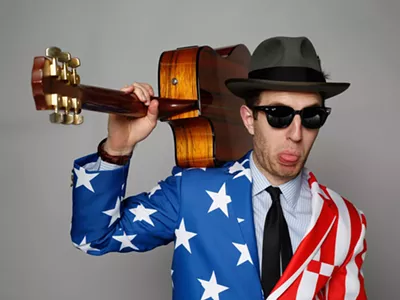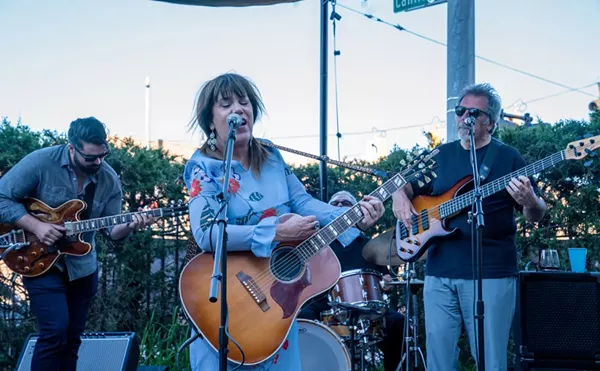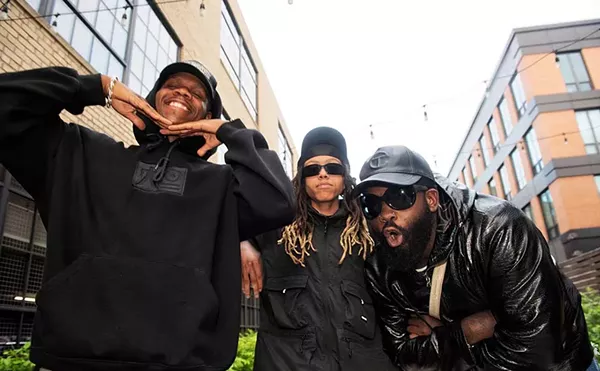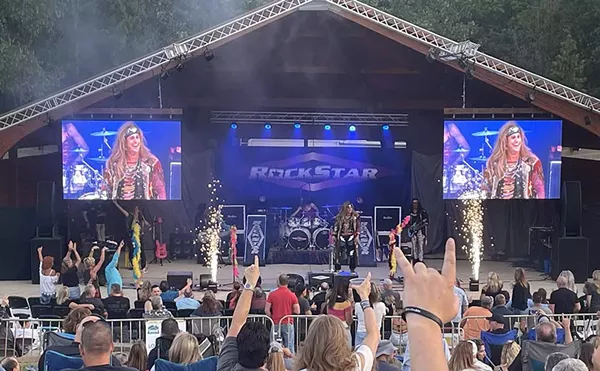
Audio By Carbonatix
[
{
"name": "GPT - Leaderboard - Inline - Content",
"component": "35519556",
"insertPoint": "5th",
"startingPoint": "3",
"requiredCountToDisplay": "3",
"maxInsertions": 100,
"adList": [
{
"adPreset": "LeaderboardInline"
}
]
}
]
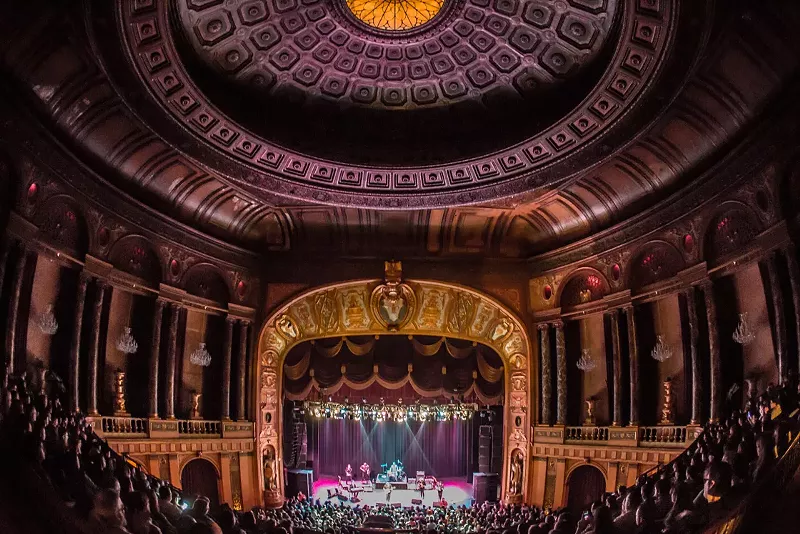
Courtesy of thefillmoredetroit.com
The Fillmore Detroit
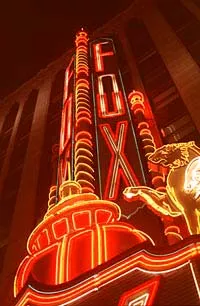
Fox Theater
Opened in 1928, this C. Howard Crane architectural masterpiece became known as “the most magnificent Temple of Amusement in the World.” When you walk through the doors of the Fox you can’t help be feel immersed in its grandeur and elegance. During the '50s and '60s, you could catch musical acts like Berry Gordy’s annual Motown Review or the “King of Rock and Roll,” Elvis Presley. But as the city began to decline in the late '60s and '70s, the Fox also began fall by the wayside. Thanks to the restoration efforts of the Ilitch family during the '80s, this Detroit landmark has stood the test of time. Perhaps you were lucky enough to snag tickets to Prince’s sold out 2015 gig, or you were present during what would become Chris Cornell’s final performance with Soundgarden in 2017. There’s no denying the historic significance of this music venue.Grande Ballroom

Ron Asheton at the Grande Ballroom, 1970.
If you’re from Detroit and you don’t know the Grande, you should do yourself a favor and get hip to the history of this counterculture hub. Dubbed the "hippie capitalist center of Detroit," the Grande became a breeding ground for the Detroit hard rock scene during the 1960s. With house bands such as MC5 and Iggy Pop and the Stooges, every night at the Grande was a guaranteed shit show of high-energy, heavy rock. The Grande Ballroom even attracted artists such as Cream, The Grateful Dead, and the Who. It was here that the MC5 recorded their debut album, Kick Out The Jams, which became one of the most highly regarded live rock albums of all time. Unfortunately, in 1972 the Grande Ballroom closed its doors to the public and hasn’t been open since its heydey almost 50 years ago. But the spirit of the Grande still lives on, and you can hear it in lead singer Rob Tyner’s voice when he announces: “It's time to... kick out the jams, motherfuckers!”
St. Andrew’s Hall

Courtesy photo
Resolution Ball at the Fillmore.
St. Andrew’s Hall is best known for showcasing groundbreaking musical acts and trendsetting artists. What began as a meeting club for St. Andrew’s Scottish Society of Detroit in 1908 has continued to be a meeting place for concert-goers and music lovers today. During the early '80s, you could experience artists such as Jane’s Addiction and the Red Hot Chili Peppers in this 1,000-person capacity venue. Adele performed her first U.S. tour in this small hall, and John Mayer has also been known to jam on this stage. St. Andrew’s has set the bar as being an intimate and unforgettable music hall.
The Shelter
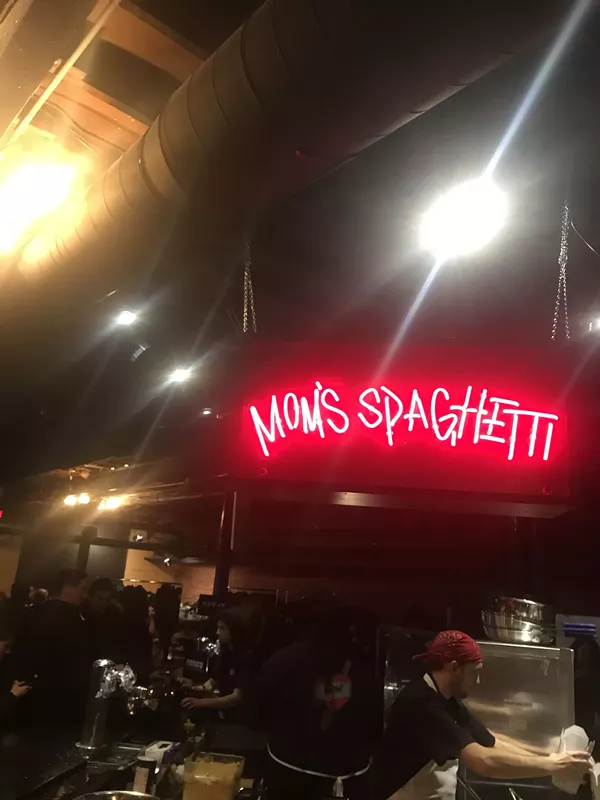
Located just below St. Andrew’s Hall, The Shelter has proven to be the ultimate, intimate fan and artist experience. With only a 400-person capacity, The Shelter has hosted artists such as Eminem, Queens of the Stone Age, and the Hives. It was here that a young Marshall Mathers would rap rhymes in freestyle battles and eventually gain enough momentum to embrace the Slim Shady alter ego. In 2017, Eminem returned to The Shelter to pay homage to his early career roots and promote his latest album Revival with a “Mom’s Spaghetti” themed pop-up shop.
The Ark
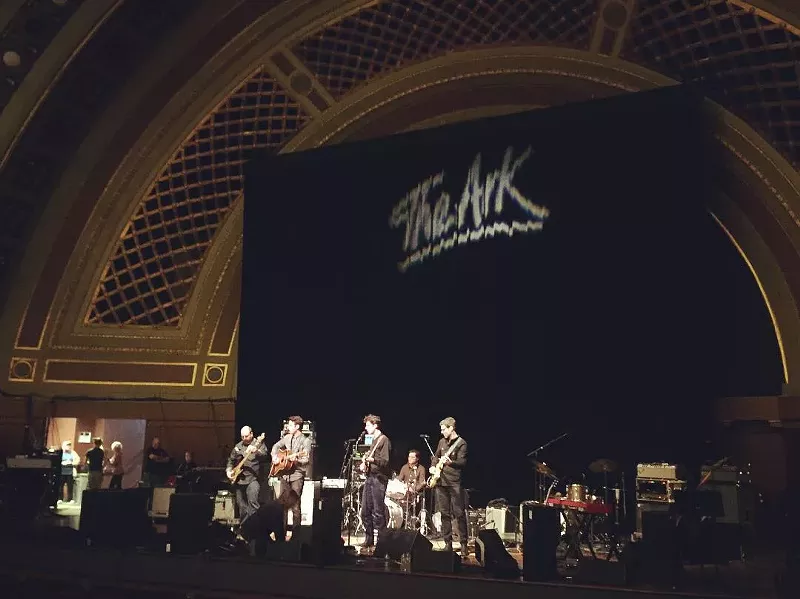
Courtesy of The Ark
The roots of this Ann Arbor venue run deep with folk music culture. Opened in 1965, The Ark served as a creative space for students to express themselves through music, art, and poetry. The Ark was a haven for students to speak freely about their concerns and connect with the community during the political and social turmoil of the 1960s. In 1977, The Ark established the Ann Arbor Folk Festival as a fundraising festival to support The Ark’s creative mission. By the late '70s, The Ark was reorganized as a non-profit organization and has remained a beacon of Ann Arbor’s music scene. Famous folkies who have gathered here include singer-songwriter Joan Baez, punk poetess Patti Smith, the legendary Arlo Guthrie, and contemporary folk favorites such as Alison Krauss, Iron and Wine, and the Avett Brothers.
The Blind Pig
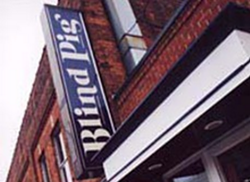
The Silverdome

tigerstadiumdetroit.com
It took not one, but two demolition explosions to tear down the mighty Pontiac Silverdome in December 2017. Football fans remember the Silverdome as the home of the Detroit Lions from 1975 through 2002 and the stadium of Super Bowl XVI. The Silverdome also welcomed wrestling fans to watch WWE superstar Hulk Hogan defend his heavyweight title against André the Giant during WrestleMania III. Led Zeppelin played a historic gig at the Silverdome during their fabled 1977 North American Tour to a crowd of 76,229 and set the attendance record for a single act show at the time. The Pontiac Silverdome is now gone, but its memory will continue on.
Cobo Hall
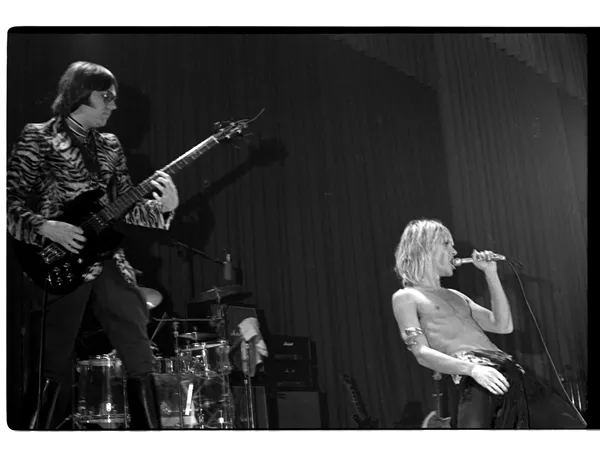
Located in the heart of downtown, Cobo Hall has served as a pillar of Detroit history. Cobo officially opened in 1960 and held numerous events from presidential conventions and concerts to figure skating and roller derby. On June 23, 1963, Martin Luther King organized the Detroit Walk to Freedom and rallied thousands of civil rights activist to march against segregation and violence. The march concluded at Cobo Hall where King delivered a precursor to what would be his famous “I Have a Dream Speech.” Cobo is also known as the location of the notorious Nancy Kerrigan attack, where the skater was bludgeoned in the knee before competing the 1994 U.S. Figure Skating Championships. Many artists have rocked these halls too, including the Doors, Queen, Kiss, and Parliament-Funkadelic. Cobo Hall has also gained attention as the host of the North American International Auto Show and has invited guests from all over the world to the visit the Motor City.
Cliff Bell's

Courtesy photo
Cliff Bell’s was established in 1935 by Detroit entrepreneur John Clifford Bell. Bell came to the city with a thirst for the nightlife and was an ambitious and unstoppable force during the years of prohibition. He ran several speakeasies around downtown before finally establishing Cliff Bell’s on Park Avenue. Bell ran the club until his retirement in 1958, but by 1985 the club closed and remained hollow until 2005. New owners Paul Howard, Scott Lowell, and Carolyn Howard began renovations on the historic club and six months later reopened in 2006. Cliff Bell’s is a reminder of the illustrious post-prohibition period and continues to uphold its 1930s club aesthetic, a beautiful structure of mahogany and brass with nightly jazz music performances and saucy cocktails.
Olympia Stadium
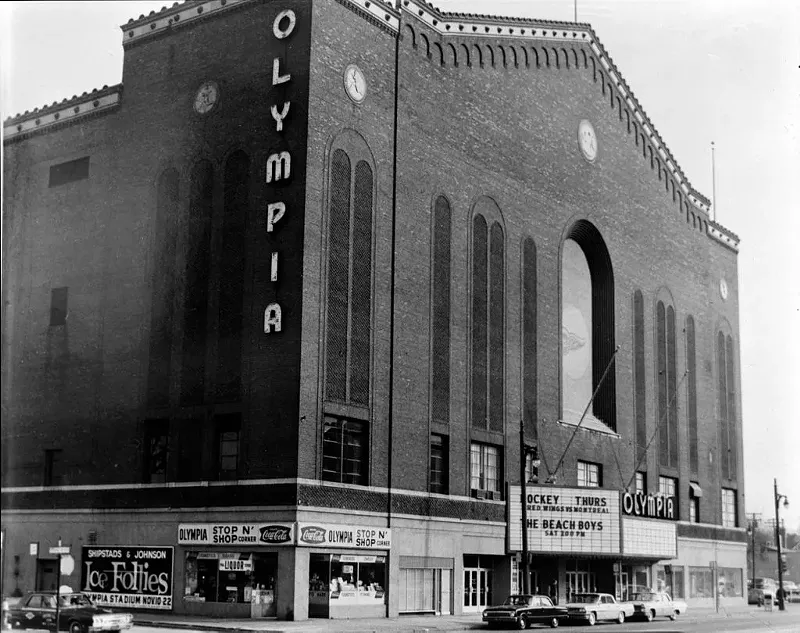
By G.G. from Hoxie, Kansas, USA [CC BY 2.0 (https://creativecommons.org/licenses/by/2.0)], via Wikimedia Commons
Olympia Stadium was the first home of the Detroit Red Wings and one of the first large-scale entertainment venues in the world. Thanks again to the architectural vision of C. Howard Crane, the conception of a sports and convention arena came to light in 1927. Generations of Detroiters grew up enjoying the spectacle of the Olympia and witnessing some of the greatest boxing matches, hockey games, and concert experiences in the history of Detroit. Joe Louis thrilled crowds with his boxing talent and prowess, Gordie Howe aka “Mr. Hockey” led the Red Wings to numerous Stanley Cup victories, and the Beatles performed here to an audience of frenzied fans in 1964 and 1966. The Red Wings played their final game at Olympia Stadium in 1979 and in 1987 Olympia was finally demolished. Although the Olympia Stadium no longer stands, it still remains a significant piece in Detroit’s history.
Joe Louis Arena
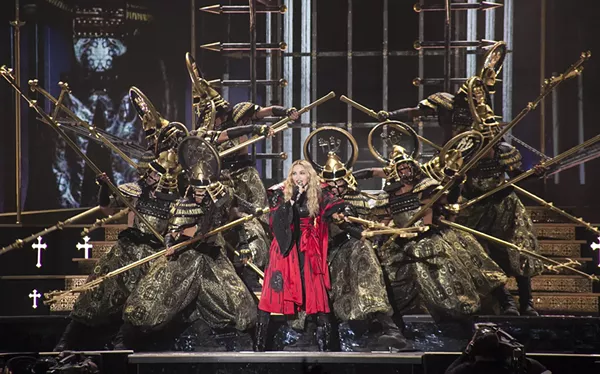
Tony Lowe
Saying goodbye to the Joe was a bittersweet moment for many Detroiters in 2017. The arena opened in 1979 as the replacement for Olympia Stadium and became the house of worship for devout Red Wings fans. Joe Louis Arena was also the epicenter of major concerts for Detroit, where you could see everybody from Aretha Franklin, Elton John, the Eagles, Kanye West, N.W.A., Lady Gaga, and the Black Keys. Who could forget Big Sean’s epic performance in 2015 when he brought Eminem on stage for a rendition of “Detroit vs. Everybody,” or Prince’s seven-night stint in 1984 to kick off his “Purple Rain” Tour? The Red Wings played their final game against the New Jersey Devils in April 2017 and relocated the hockey franchise to the new Little Caesars Arena in Midtown. If you’ve grown up with Detroit, you’ve probably shared and made some memories with the Joe.
Vanity Ballroom
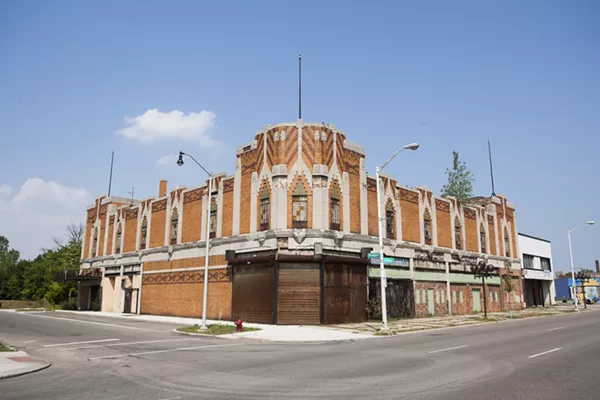
Albert Duce for Wikimedia Commons
During the 1930s and 1940s, the Vanity Ballrooms served as a hotspot for dancing and socializing on Detroit’s east side. The ballroom featured a large maple dance floor built on springs to keep dancers light on their feet and a rotating chandelier with light reflecting mirrors — think early 20th-century disco ball. The Vanity was dressed in Art Deco design and displayed images of Mayan culture throughout the ballroom, including a mural of Chichen Itza as the backdrop of the bandstand. Back in the day, you could listen to jazz greats like Duke Ellington, Cab Calloway, and Ella Fitzgerald at the Vanity and dance the night away at "Detroit's most beautiful dance rendezvous." Sadly, the club closed in 1958 and has been in disrepair since the 1980s.
Harper Theater/Harpos
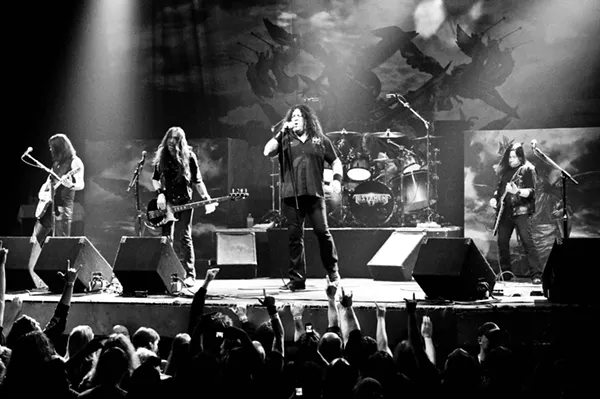
Shane Glenn
This venue began as a movie theater in 1939, but by 1979 the Harper Theatre transformed and rebranded into the hard rock Harpos. Throughout the years Harpos has welcomed a variety of performers to their stage including Motörhead, Anthrax, Ronnie James Dio, Megadeth, Slayer, and Iron Maiden. Harpos has been a long time hard rock venue in Detroit and had a reputation that matched the attitude of their hard-hitting heavy metal audience. Reports of shootings, car theft, and break-ins were common in the neighborhood surrounding the venue, but concert-goers were still drawn to the gritty and grungy atmosphere of Harpos — after all, not giving a shit is what rock 'n' roll
Detroit Masonic Temple
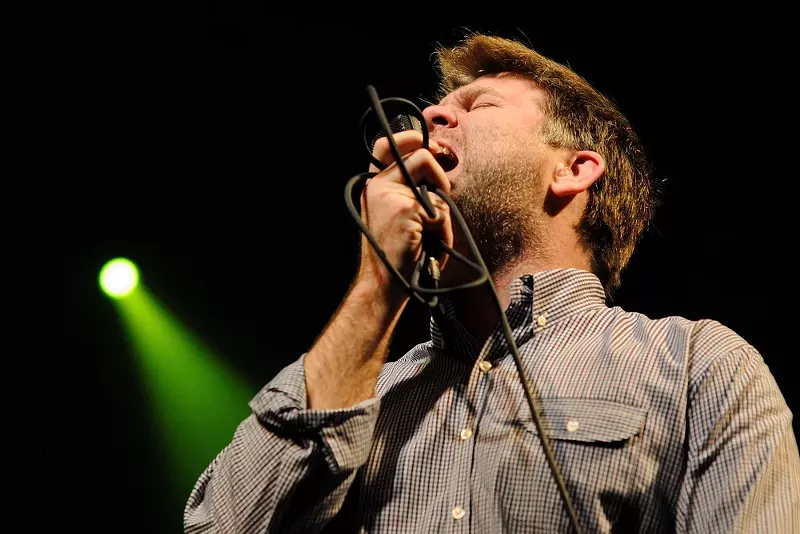
Shutterstock
James Murphey of LCD Soundsystem.
Since 1926, the Masonic Temple has stood as a homage to the history of Masons, one of Detroit’s oldest social organizations. The architecture reflects a neo-gothic style and holds two large concert halls capable of hosting Broadway shows, concerts, and various ceremonies. In 1968, the Jimi Hendrix Experience played an unforgettable show at the Masonic with Detroit rockers the MC5, Soft Machine, and the Rationals. The White Stripes were no stranger to the Masonic and performed here several times throughout their career. Thanks to the generosity of Detroit native and musician Jack White, the Masonic was saved from foreclosure in 2013 after he paid off back taxes owed to Wayne County. The Masonic Temple was so grateful that they renamed the Scottish Rite Cathedral the Jack White Theater.
Michigan Theater
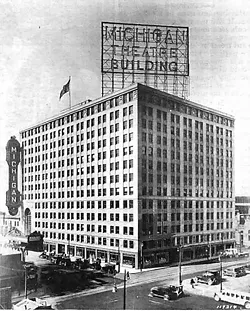
via Wikimedia Commons
Majestic Theater
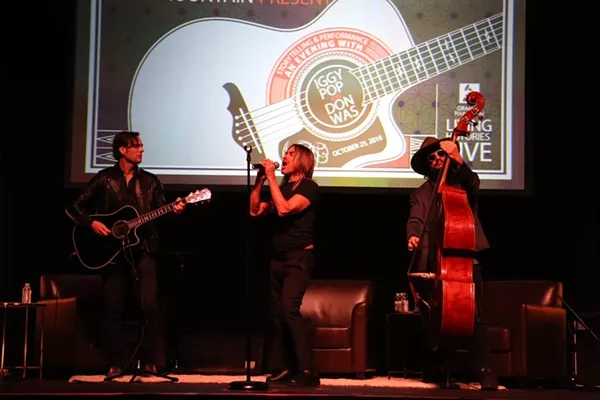
Photo by Loreen Sarkis/Courtesy of The Recording Academy®/WireImage.com.
Dean Fertita, left, Iggy Pop, and Don Was play at The Majestic.
The Majestic Theater is still alive and well since its opening in 1915. The Majestic began as a movie theater and transitioned into a church, photography studio, and then finally a music venue in 1984. Numerous musical acts have performed here from a variety of genres including the Flaming Lips, Drake, M83, St. Vincent, Ghost and Leon Bridges. The Majestic operates along with the Magic Stick, a smaller club venue which has promoted bands such as OK Go, Frank Turner, New Found Glory, and Gogol Bordello.
Royal Oak Music Theater
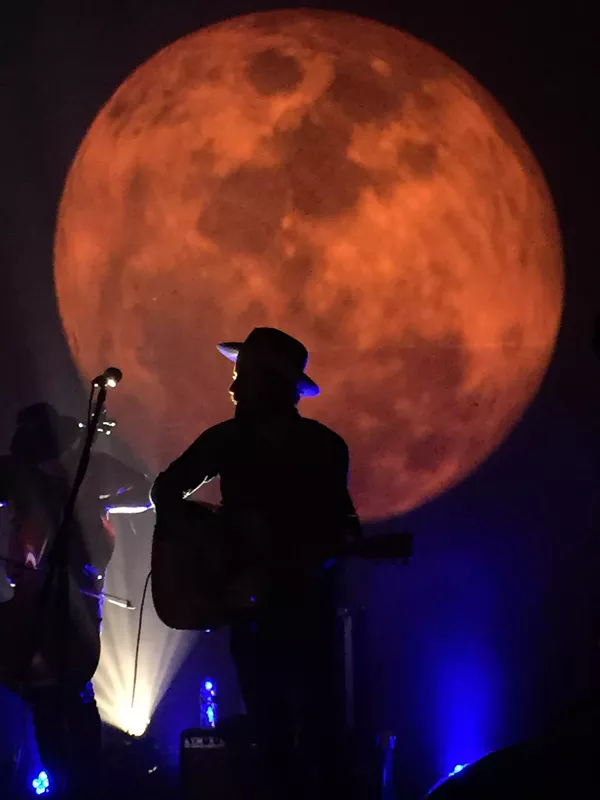
Royal Oak had its start as the “Kunsky Royal Oak,” a vaudeville theater in 1928 named after Detroit entrepreneur John H. Kunsky. The Kunsky was one of the most successful suburban movie theaters, but by 1978 it began promoting live entertainment and became known as the Royal Oak Music Theater. Hall & Oates were among some of the first concerts at Royal Oak during the late '70s, and by 2007 AEG Live franchised the theater and began promoting artists such as Elvis Costello, Morrissey, A Day To Remember, Skrillex, Wiz Khalifa,
The Palace

Photo by Jarrett Koral.
The Palace of Auburn Hills is known mostly as the home of the Detroit Pistons basketball team. The Pistons began playing the Palace in 1988 and gained enough momentum to win NBA Championships in 1989, 1990, and 2004. The Palace was also the site of some amazing concerts including Michael Jackson’s 1988 “Bad” World Tour, Van Halen, the Cure, and Sting. In September 2017 Bob Seger performed the final concert at the Palace, and the Pistons negotiated a relocation to Little Caesars Arena. The Palace still stands today, but the future of this Auburn Hills venue is uncertain.
DTE Energy Music Theater
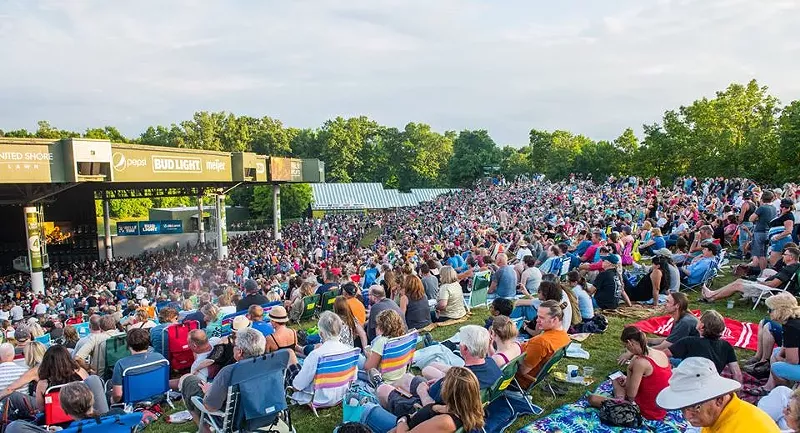
'Safe' concertgoers & their blankets/chairs
Pine Knob Music Theater opened in 1972 and has filled its grassy hills every summer with thousands of fans to enjoy music from artists such as Bob Dylan, Diana Ross, Chicago, Fleetwood Mac, and Stevie Wonder. Beginning in 1989, Eddie Money has opened the concert season at DTE for nearly 30 years (with the exception of 1995). When Lollapalooza was still in its touring days, it made a stop at Pine Knob in 1991 with Jane’s Addiction headlining. Kid Rock broke concert records in 2015 by performing 10 consecutive sold-out shows at DTE. Although Pine Knob was renamed DTE Energy Music Theater, fans still recall the peak of Pine Knob.
Kara Frank is a summer editorial intern at Metro Times.
Get our top picks for the best events in Detroit every Thursday morning. Sign up for our events newsletter.


